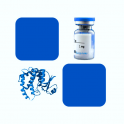
- Remove this product from my favorite's list.
- Add this product to my list of favorites.
Products
Newsletter
 |  |  |  |  |  |

Background
Proprotein convertase subtilisin/kexin type 9 (PCSK9), is an enzyme which in humans is encoded by the PCSK9 gene.This gene encodes a proprotein convertase belonging to the proteinase K subfamily of the secretory subtilase family. This protein plays a major regulatory role in cholesterol homeostasis. PCSK9 binds to the epidermal growth factor-like repeat A (EGF-A) domain of the low-density lipoprotein receptor (LDLR), inducing LDLR degradation. PCSK9 may also have a role in the differentiation of cortical neurons. Mutations in this gene have been associated with a rare form of autosomal dominant familial hypercholesterolemia (HCHOLA3).
Source
Recombinant Rat PCSK9, His Tag (PC9-R52H4) is expressed from human 293 cells (HEK293). It contains AA Gln 31 - Gln 691 (Accession # P59996-1).
Predicted N-terminus: Gln 31
Molecular Characterization
This protein carries a polyhistidine tag at the C-terminus. This protein undergoes autocatalytic cleavage to release the pro-peptide and mature chain. The pro-peptide and mature chain are associated through non‑covalent interactions and with a calculated MW of 13.9 kDa and 59.3 kDa respectively. The protein migrates as 16 kDa and 60-66 kDa under reducing (R) condition (SDS-PAGE) due to glycosylation.
Endotoxin
Less than 1.0 EU per μg by the LAL method.
Purity
>95% as determined by SDS-PAGE.
Formulation
Lyophilized from 0.22 μm filtered solution in 50 mM Tris, 150 mM NaCl, pH7.5 with trehalose as protectant.
Reconstitution
Please see Certificate of Analysis for specific instructions.
For best performance, we strongly recommend you to follow the reconstitution protocol provided in the CoA.
Storage
For long term storage, the product should be stored at lyophilized state at -20°C or lower.
Please avoid repeated freeze-thaw cycles.
This product is stable after storage at:
-20°C to -70°C for 12 months in lyophilized state;
-70°C for 3 months under sterile conditions after reconstitution.
Bioactivity
Please refer to product data sheet.
(1) "Causal association between lipid-lowering drugs and cancers: A drug target Mendelian randomization study"
Ding, Chen, Xia et al
Medicine (Baltimore) (2024) 103 (18), e38010
(2) "Immuno-modulatory role of baicalin in atherosclerosis prevention and treatment: current scenario and future directions"
Wang, Huang, Liang et al
Front Immunol (2024) 15, 1377470
(3) "Hypercholesterolemia: a literature review on management using tafolecimab: a novel member of PCSK9 monoclonal antibodies"
Qureshi, Khanzada, Safi et al
Ann Med Surg (Lond) (2024) 86 (5), 2818-2827
Showing 1-3 of 6032 papers.
Follow us